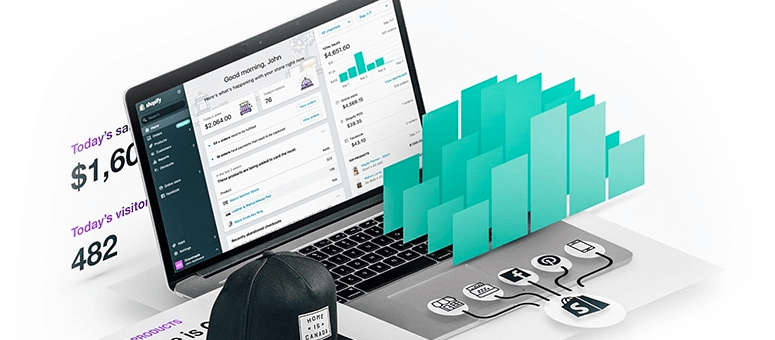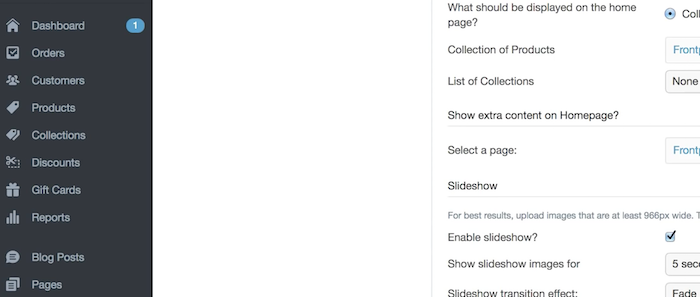Shopify Review: All the Pros and Cons

Shopify was founded in Ontario, Canada in 2004. As is indicated by its name, Shopify is an eCommerce website builder platform that is also dynamic enough to function as a retail point of sale in a store. As of 2017, the more than 350,000 people who use the platform have made over $15 billion in sales.
While it is clear that Shopify is a very effective medium for making sales, we wanted to know if it was just as capable when it comes to website building. We signed up for an account to find the strengths and weaknesses of the platform.
- Shopify Highlights
- Pros and Cons of Shopify
- Ease of Use
- User Interface
- Pricing
- Customer Support
- Final Thoughts
Shopify Highlights
New Shopify users can begin using the software right away with a 14-day free trial. We always prefer services that offer a generous trial period, because not only does it give us the opportunity to try the software, but also implies that the company is confident in their product.
Shopify is connected to a vibrant app market, which is filled with add-ons that can expand your website’s features, functionality, and potential for success. The eCommerce platform accepts a multitude of payment options in nearly every currency and is available to use in approximately 150 countries.
Pros and Cons of Shopify
Pros
- Over one hundred free and paid professionally designed templates that most other builders can't even touch.
- A great library of free and premium third-party apps make your business more capable.
- Live chat and customer support is available whenever you need it, creating a safety net around your business.
Cons
- Some plans are expensive, and fees and paid add-ons can add up quickly.
- Features and editing tools may overwhelm people who have never created a website, or run an online business.
- Full customization of websites can only be done with a proprietary coding language called Liquid.
Ease of Use
Since Shopify is geared towards anyone who wants to start an online business, it shouldn’t come as a surprise that the platform is extremely easy to use. There is a tutorial that walks you through the sign-up and website building process, so once the tutorial is over, you shouldn’t have a problem creating and altering your website.
The templates are separated into many categories. Premium templates are somewhat costly at $180 each, so be prepared to spend some money if you find a template you absolutely love but isn’t free. Once you choose your template, uploading your product images, and filling your website with information, as well as editing the overall design of your website is extremely easy to do. In fact, it is so easy, that you are guaranteed to have your website designed and live within minutes.
User Interface

The Shopify user interface is reminiscent of the WordPress dashboard, relying on a sidebar to direct you to all of your customizable settings. Users are provided with all of the information they need at a glance, including Orders, Customers, Products, Reports, and Blog Posts.
Adding products is as simple as typing in product information and you can even add variants of products with a single click of a button. Shopify has built-in gift card management, allowing you to offer customers the option of purchasing credit. Discounts are also simply inputted via the easy-to-use dashboard.
Customizing your actual site is just as simple, although unlike website builders that use a drag-and-drop interface like Wix, all website edits are made using a text entry interface, making the themes less customizable unless you have coding experience and knowledge of Shopify's proprietary Liquid programming language.
Pricing
Shopify offers a free 14-day trial for everyone who signs up. Although a credit card is not required to receive this free trial, if you are interested in keeping your store on Shopify’s platform, then be prepared to spend some money. Below is a chart of Shopify’s package prices.
Package Name | Lite | Basic | Pro | Unlimited |
Price | $9 per month | $29 per month | $79 per month | $179 per month |
Ways to Sell |
|
|
|
|
Credit Card Rates | Online: 2.9% + 30 cents In Person: 2.7% + 0 cents | Online: 2.9% + 30 cents In Person: 2.7% + 0 cents | Online: 2.6% + 30 cents In Person: 2.4% + 0 cents | Online: 2.4% + 30 cents In Person: 2.2% + 0 cents |
Transaction Fees | Using Shopify Payments: None Using External Payment Gateways: 2% | Using Shopify Payments: None Using External Payment Gateways: 2% | Using Shopify Payments: None Using External Payment Gateways: 1% | Using Shopify Payments: None Using External Payment Gateways: 0.5% |
Features |
|
|
|
|
Most people sign up for the Basic package, while people who just launched their online business sign up for the Lite package, and people who have a bustling online business sign up for the Unlimited package.
Customer Support
Shopify has amazing customer support that is offered 24/7. You can choose to email Shopify’s customer support center, engage in a live chat session with a representative, or even call Shopify’s phone number to speak to a live representative.
There is also an excellent online help center which can be used to seek out answers on your own.
Final Thoughts
Overall, if you have an idea for an online business, and you want to make it successful, Shopify is the perfect website building platform to kickstart and market your business. It is extremely feature rich, offering everything you might possibly need for your business and more.
